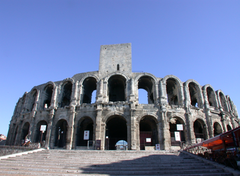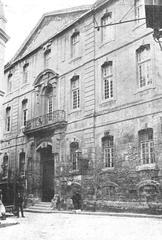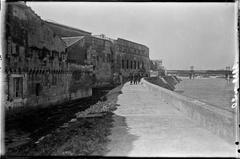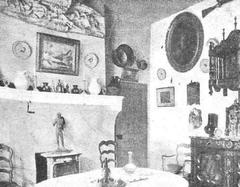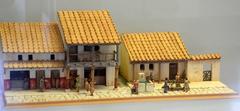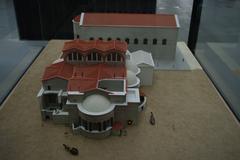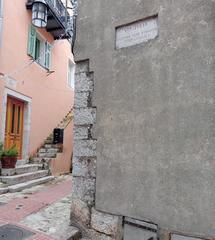Église Saint-Jean-De-Moustiers: Visiting Hours, Tickets, and Historical Significance in Arles, France
Date: 14/06/2025
Introduction
Nestled within the UNESCO-listed heart of Arles, the Église Saint-Jean-De-Moustiers stands as a vital yet understated emblem of the city’s layered religious and architectural legacy. Dating back to the early medieval period, with significant Romanesque transformation in the 12th century, this church—historically linked to the earliest Christian communities in Provence—offers a unique window into the evolution of sacred spaces in southern France. Despite its partial integration into the urban fabric and limited public access, the site’s remaining architectural features and archaeological traces serve as a silent witness to centuries of faith, art, and community life in Arles.
This comprehensive guide explores the historical background, architectural highlights, cultural importance, and practical visitor information for Église Saint-Jean-De-Moustiers. Whether you are an architecture enthusiast, historian, or curious traveler, this resource will help you appreciate Arles’ hidden gem and plan a meaningful visit.
Table of Contents
- Introduction
- Historical Overview
- Architectural Features and Transformations
- Visiting Église Saint-Jean-De-Moustiers: Practical Information
- Cultural and Religious Importance
- Preservation and Current Status
- Recommendations for a Meaningful Visit
- FAQ
- Conclusion
- References
Historical Overview
Origins and Early Foundations
Église Saint-Jean-De-Moustiers traces its origins to the 5th or 6th century, marking it as one of Arles’ earliest Christian sites. The name “Moustiers” derives from the Latin “monasterium,” highlighting its monastic associations and role as a spiritual nucleus in early Christian Provence. Historical evidence suggests the site may have been linked to the city’s first cathedral baptistery, underscoring its foundational role in Arles’ religious development (Arles Tourism).
Medieval Development and Ecclesiastical Role
By the 12th century, the church had undergone a significant Romanesque transformation, becoming a parish church dedicated to Saint John the Baptist. Its close ties to the influential Monastery of Saint-Césaire and integration into the Via Tolosana pilgrimage route solidified its status as both a local and regional spiritual landmark. The church played a vital role in the religious and communal life of Arles, hosting rituals, festivals like the Fête de la Saint-Jean, and acting as a waypoint for pilgrims en route to Santiago de Compostela (UNESCO World Heritage).
Architectural Features and Transformations
Exterior and Romanesque Elements
The church’s exterior is distinguished by a semi-circular chevet with classical pilasters and acanthus leaf capitals, echoing Roman architectural motifs. The chevet is partially buried below street level, a testament to centuries of urban development in Arles. Although much of the original structure was lost or absorbed by adjacent buildings, these surviving elements vividly illustrate the Provençal Romanesque style’s adaptation of ancient forms (Église Saint-Jean-de-Moustiers - AST Arles).
Interior Layout and Decorative Program
Originally designed with a single nave and two bays, only one bay survives today. The apse features a semi-dome (cul-de-four) vault with radiating ribs from a keystone inscribed “Ecce Agnus Dei” (“Behold the Lamb of God”), a powerful symbol of Christ’s sacrifice. Blind arcatures along the apse walls, fragments of medieval frescoes, and sculpted capitals—depicting biblical scenes and vegetal motifs—add to the church’s serene and instructive atmosphere (Audiala Guide).
Later Modifications and Decline
Over the centuries, urban encroachment led to the absorption of parts of the nave and the eventual cessation of regular worship services. By the 18th and 19th centuries, the church was partially dismantled, with some stones repurposed elsewhere in Arles. Today, its remains are preserved as significant architectural heritage and as an archaeological site (Nomads Travel Guide).
Cultural and Religious Importance
Église Saint-Jean-De-Moustiers has long been a focal point for worship, pilgrimage, and community activities. Its dedication to Saint John the Baptist, central role in the Fête de la Saint-Jean, and integration in the medieval pilgrimage network reflect its enduring spiritual significance. The church also participated in charitable works and served as a hub for social and cultural exchange within Arles.
The location’s proximity to major sites like the Alyscamps necropolis and Saint-Trophime Cathedral highlights its role in Arles’ sacred landscape. The church’s history of coexistence with the city’s Jewish and Muslim communities, as well as its artistic influence during periods such as Vincent van Gogh’s stay in Arles, further enrich its cultural narrative (The Empty Nest Explorers).
Visiting Église Saint-Jean-De-Moustiers: Practical Information
Visiting Hours and Ticket Information
- Regular Access: The site is not open for regular interior visits. The archaeological remains are viewable from the exterior year-round during daylight hours (generally 9:00 AM–6:00 PM).
- Tickets: Entry is free; no ticket is required for the exterior. Occasionally, special events or guided tours may grant access to additional areas—check with the Arles Tourism Office for updates.
- Guided Tours: Offered through the tourism office or as part of city walking tours. Advance booking is recommended for special access or group tours.
Accessibility
Due to partial burial and urban integration, the site is not fully accessible for persons with reduced mobility. The ground is uneven, and there are no dedicated facilities at the church itself.
How to Get There
Église Saint-Jean-De-Moustiers is centrally located in Arles’ historic district, within walking distance of major landmarks such as the Roman Amphitheatre, the Alyscamps, and Saint-Trophime Cathedral. Parking is available at city lots; the site is easily reached on foot from train and bus stations.
Nearby Attractions
- Roman Amphitheatre: A well-preserved ancient arena hosting events and tours.
- Alyscamps Necropolis: A famed Roman burial ground with early Christian significance.
- Saint-Trophime Church and Cloister: A masterpiece of Romanesque architecture and sculpture.
- Forum Square: The bustling heart of Arles, immortalized by van Gogh (Nomads Travel Guide).
Guided Tours and Photography Tips
Most city walking tours include a stop at Église Saint-Jean-De-Moustiers’ exterior. Photography is permitted—capture the Romanesque details and the site’s atmospheric integration into Arles’ historic streetscape. Please refrain from climbing or disturbing the archaeological remains.
Preservation and Current Status
While much of the church has disappeared, the surviving chevet, apse, and foundation fragments are protected as part of Arles’ architectural heritage. Local conservation groups and scholars continue to study and preserve the site, and its story is shared through digital guides and interpretive panels (Église Saint-Jean-de-Moustiers - AST Arles).
Recommendations for a Meaningful Visit
- Visit during early morning or late afternoon for the best light and quiet atmosphere.
- Combine your visit with nearby Roman and medieval sites for a comprehensive experience.
- Join a guided tour for in-depth historical context.
- Respect the site’s fragility: Do not climb on ruins and keep noise to a minimum.
- Enhance your visit using digital resources like the Audiala app.
FAQ
Q: What are the visiting hours of Église Saint-Jean-De-Moustiers?
A: The exterior and archaeological remains are accessible year-round during daylight hours, typically 9:00 AM–6:00 PM.
Q: Is there an entrance fee or ticketing?
A: No, visiting the site’s exterior is free. Guided tours or special event access may incur a fee.
Q: Is the church accessible for visitors with reduced mobility?
A: The site has uneven ground and limited accessibility; please consult the tourism office for assistance.
Q: Can I take photographs?
A: Yes, photography is allowed and encouraged for personal use.
Q: How do I get there?
A: The church is centrally located and reachable on foot from the train station or city center parking lots.
Q: Are there guided tours?
A: Yes, city walking tours and special events may include the church. Use the Arles Tourism Office or the Audiala app for details.
Conclusion
Église Saint-Jean-De-Moustiers is a hidden yet vital thread in Arles’ historical tapestry, embodying the city’s journey from Roman provincial capital to medieval religious center. Its Romanesque remnants and archaeological features offer a tangible connection to the spiritual and artistic traditions of Provence. Though modest in appearance today, the church’s enduring presence invites visitors to contemplate the deep roots of faith, community, and cultural exchange that define Arles. For the most up-to-date information on special openings and tours, consult the Arles Tourism Office and enhance your visit with digital resources like the Audiala app.
Useful Links
- Official Arles Tourism
- Église Saint-Jean-de-Moustiers - AST Arles
- Visit Arles - Sortie Visite
- Nomads Travel Guide
- UNESCO World Heritage
- Audiala Guide
- France Voyage Events
Alt text suggestions for images:
- “Exterior view of Église Saint-Jean-de-Moustiers chevet with Romanesque pilasters in Arles”
- “Close-up of acanthus leaf capitals on Église Saint-Jean-de-Moustiers chevet”
- “Map showing location of Église Saint-Jean-de-Moustiers in Arles historic district”
- “Photograph of the cul-de-four vaulted apse interior (archival or illustrative)”

